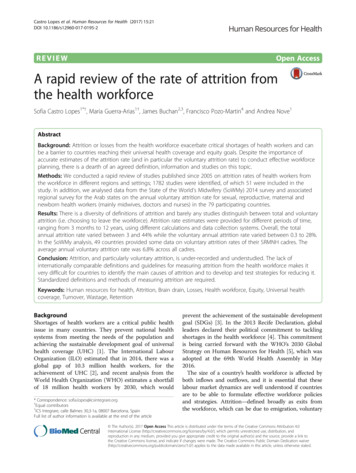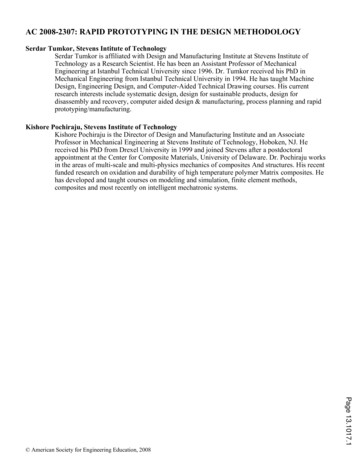
Transcription
Castro Lopes et al. Human Resources for Health (2017) 15:21DOI 10.1186/s12960-017-0195-2REVIEWOpen AccessA rapid review of the rate of attrition fromthe health workforceSofia Castro Lopes1*†, Maria Guerra-Arias1†, James Buchan2,3, Francisco Pozo-Martin4 and Andrea Nove1AbstractBackground: Attrition or losses from the health workforce exacerbate critical shortages of health workers and canbe a barrier to countries reaching their universal health coverage and equity goals. Despite the importance ofaccurate estimates of the attrition rate (and in particular the voluntary attrition rate) to conduct effective workforceplanning, there is a dearth of an agreed definition, information and studies on this topic.Methods: We conducted a rapid review of studies published since 2005 on attrition rates of health workers fromthe workforce in different regions and settings; 1782 studies were identified, of which 51 were included in thestudy. In addition, we analysed data from the State of the World’s Midwifery (SoWMy) 2014 survey and associatedregional survey for the Arab states on the annual voluntary attrition rate for sexual, reproductive, maternal andnewborn health workers (mainly midwives, doctors and nurses) in the 79 participating countries.Results: There is a diversity of definitions of attrition and barely any studies distinguish between total and voluntaryattrition (i.e. choosing to leave the workforce). Attrition rate estimates were provided for different periods of time,ranging from 3 months to 12 years, using different calculations and data collection systems. Overall, the totalannual attrition rate varied between 3 and 44% while the voluntary annual attrition rate varied between 0.3 to 28%.In the SoWMy analysis, 49 countries provided some data on voluntary attrition rates of their SRMNH cadres. Theaverage annual voluntary attrition rate was 6.8% across all cadres.Conclusion: Attrition, and particularly voluntary attrition, is under-recorded and understudied. The lack ofinternationally comparable definitions and guidelines for measuring attrition from the health workforce makes itvery difficult for countries to identify the main causes of attrition and to develop and test strategies for reducing it.Standardized definitions and methods of measuring attrition are required.Keywords: Human resources for health, Attrition, Brain drain, Losses, Health workforce, Equity, Universal healthcoverage, Turnover, Wastage, RetentionBackgroundShortages of health workers are a critical public healthissue in many countries. They prevent national healthsystems from meeting the needs of the population andachieving the sustainable development goal of universalhealth coverage (UHC) [1]. The International LabourOrganization (ILO) estimated that in 2014, there was aglobal gap of 10.3 million health workers, for theachievement of UHC [2], and recent analysis from theWorld Health Organization (WHO) estimates a shortfallof 18 million health workers by 2030, which would* Correspondence: sofia.lopes@icsintegrare.org†Equal contributors1ICS Integrare, calle Balmes 30,3-1a, 08007 Barcelona, SpainFull list of author information is available at the end of the articleprevent the achievement of the sustainable developmentgoal (SDGs) [3]. In the 2013 Recife Declaration, globalleaders declared their political commitment to tacklingshortages in the health workforce [4]. This commitmentis being carried forward with the WHO’s 2030 GlobalStrategy on Human Resources for Health [5], which wasadopted at the 69th World Health Assembly in May2016.The size of a country’s health workforce is affected byboth inflows and outflows, and it is essential that theselabour market dynamics are well understood if countriesare to be able to formulate effective workforce policiesand strategies. Attrition—defined broadly as exits fromthe workforce, which can be due to emigration, voluntary The Author(s). 2017 Open Access This article is distributed under the terms of the Creative Commons Attribution 4.0International License (http://creativecommons.org/licenses/by/4.0/), which permits unrestricted use, distribution, andreproduction in any medium, provided you give appropriate credit to the original author(s) and the source, provide a link tothe Creative Commons license, and indicate if changes were made. The Creative Commons Public Domain Dedication o/1.0/) applies to the data made available in this article, unless otherwise stated.
Castro Lopes et al. Human Resources for Health (2017) 15:21exits (e.g. to other sectors of employment), illness, deathor retirement—is an important element of outflows fromthe labour market and something that governments candirectly influence by implementing strategies for healthworker motivation and retention.To address health worker shortages and plan effectivelyfor the future, more focus needs to be dedicated to theissue of workforce attrition. High levels of attrition lead toa large loss of public resources spent on education andtraining of health workers [6]. Attrition also contributes toincreased workload and worse working conditions for theremaining workforce, which in turn contributes to lowerquality of care and worse health outcomes [7]. Exits fromthe workforce affect the projected supply of healthworkers that a country needs to meet population need forhealth care, making attrition a key component of workforce projection models [8].The 2014 State of the World’s Midwifery (SoWMy)report [9], which focused on the sexual, reproductivematernal and newborn health (SRMNH) workforce,included the voluntary attrition rate as one of the 10 essential items needed for workforce planning. However,the SoWMy report found that these data are not readilyavailable in many low- and middle-income countries.Often, countries with the largest attrition rates also havethe lowest availability of data, as they lack reliable records which track attrition and migration of healthworkers [10].One of the key components of attrition is out-migration,in particular from lower-income to higher-income countries, also known as ‘brain drain’. Driving this migration isthe large demand for health workers in high-incomecountries due to ageing populations and the increasingburden of non-communicable diseases and health workersunsatisfied with low pay and lack of career progressionopportunities in low-income countries [11, 12]. The region worst affected by this situation is sub-Saharan Africa,which also faces the most severe shortage of healthworkers [10].It is hard to quantify the effects of brain drain. Data onhealth worker registration and country of origin in destination countries is often used to measure the magnitude ofmigration [13], but it is difficult to analyse the size of outflows from individual source countries. Furthermore, theconsequences can be much more harmful than the numbers show: in low-income countries which have very fewspecialists in the health workforce, the migration of even arelatively small number of these can lead to great lossesand eliminate educational opportunities [14]. It can alsoaffect the overall institutional capacity of the health systemto effectively develop and meet population needs [6].Brain drain is considered an ethical concern as it exacerbates shortages of health workers in countries [6]. Globalarchitecture such as the WHO Global Code of Practice onPage 2 of 9International Recruitment of Health Personnel [15] recognizes the severity of the issue and strives to negotiate asolution.Health workforce attrition affects all countries invarying measures, although specific countries or regions may be hit hardest or by specific types of attrition. For example, the HIV/AIDS epidemic has led tohigher rates of attrition due to illness, death or fear ofinfection in sub-Saharan Africa [14, 16]. However, attrition rates also vary within countries along multiple dimensions: for example, by sub-national regions, bylocation (urban or rural/remote) [17, 18], by type ofhealth facility, by cadre or even by age of health worker.Retaining health workers in rural or remote areas is aparticularly complex problem that affects all countries,including high-income countries that do not generallystruggle with high rates of attrition in urban areas andnumerous studies have proposed strategies to alleviatethis problem [18].Because of the need for accurate estimates of attritionrates and the lack of data in many countries, workforceprojection models such as that used in SoWMy 2014 are(to a greater or lesser extent) reliant on assumptions andestimates until such time as data collection procedurescan be improved. This study provides a comprehensivereview of the available evidence on attrition rates anddemonstrates the wide variability according to differenttypes of health worker and different country contexts. Italso explores how attrition is measured and studies areconducted, thereby drawing attention to the need forstandard definitions and methodologies for measuringand monitoring this vital aspect of labour marketdynamics.MethodsRapid literature reviewWe conducted a rapid review of studies published since2005 on the attrition rates of health workers. Attritionwas defined as any exit from the health workforce. Wesearched the PubMed, Web of Science and HumanResources for Health (HRH) Journal databases. Thesearch expressions were adapted to each database basedon the scope and relevance of the retrieved papers. Thesearch expressions were the following: For PubMed: ((‘human resources for health’ OR‘health workforce’ OR ‘health workers’ OR ‘healthmanpower’) AND (‘attrition rate’ OR exit OR lossesOR ‘brain drain’ OR turnover OR retention)) For Web of Science: ((‘human resources for health’OR ‘health workforce’ OR ‘health workers’) AND(‘attrition rate’ OR exit OR losses OR ‘brain drain’OR turnover OR retention))
Castro Lopes et al. Human Resources for Health (2017) 15:21 For HRH Journal: ((‘human resources for health’ OR‘health workforce’ OR ‘health workers’) AND(‘attrition rate’ OR exit OR losses OR ‘brain drain’OR wastage OR turnover OR migration))Page 3 of 9two methods was then estimated and used in this study.Voluntary attrition was defined by the reasons to leave,when said reasons were presented in the studies.SoWMy 2014 datasetThe terms ‘turnover’ and ‘retention’ have differentdefinitions from attrition. However, they are often usedinterchangeably in the literature, which is why they wereincluded in the search expression: this increased thechance of collecting and extracting quantitative data orestimates of attrition.In total, 841 papers were obtained from the PubMedsearch, of which 2 were excluded as duplicates; 417 papers were obtained from the HRH Journal search, ofwhich 124 were excluded because they had alreadybeen identified via the PubMed search. From the Webof Science, 834 papers were retrieved, of which 190 wereexcluded due to duplication. Additionally, 17 papers wereidentified through expert consultation, of which 11 wereduplicates. Thus, 1782 papers were identified.A title review was carried out by two researchers, whoeach reviewed half of the 891 titles; 436 papers wereshort-listed for abstract review based on the followingcriteria: specific to HRH and reference to the use ofquantitative methods. The papers that mention the useof qualitative methods only were excluded. Upon thisabstract review, 174 of the papers were selected to beread in full because the abstract included quantitative results about attrition (% of health workers leaving theworkforce and attrition rates in a specific period oftime). Studies reporting only retention rates or % ofhealth workers retained were not considered. Of these174 papers that were read in full, 123 were excluded because they focused rather on the intention to leave ofhealth workers or on attrition from education than onactual estimation of attrition rates from the workforce.Although these are important losses which also need tobe quantified, they occur at a different stage of thelabour pipeline and therefore were beyond the scope ofthis study. Forty-five papers were selected based onthese criteria, and additional 6 papers were identified bythe authors through references from the selected paperswhich were also added to the review, making a total of51 papers (Fig. 1).A data extraction table was used to record informationon objective of the study, countries involved, study setting(nationwide, sub-national), definition of attrition, cadresinvolved, type of attrition (total or voluntary), reasons forleaving and attrition rates.Where possible, comparison of total and voluntary annual attrition rates was made. In a specific study [19],two different estimation processes were used to calculatethe average of annual attrition for each cadre by country.The mean (unweighted) of the attrition provided by theseIn addition to the rapid review, we also conducted an analysis of voluntary attrition from the SRMNH workforce,using data from the State of the World’s Midwifery 2014(SoWMy 2014) survey [9], as a large-scale of a multicountry approach. Seventy-three low- and middle-incomecountries provided data for the survey conducted in October 2013 to February 2014. The survey was completed byUnited Nations Population Fund (UNFPA) and WHOcountry offices in the participating countries, with validation of the data by stakeholders including Ministries ofHealth. In addition, six countries from the UNFPA ArabStates Region completed the same survey betweenSeptember 2014 and May 2015 for the follow-up report:Analysis of the Midwifery Workforce in selected ArabCountries [20], so these countries were also included inthis analysis.The 79 countries in the combined dataset were askedto respond to the following question for each of theirSRMNH cadres in the workforce: ‘Approximately whatpercentage of this cadre left the workforce in the lastyear for reasons other than death or reaching statutoryretirement age?’. This corresponds to the annual voluntary attrition rate. Each SRMNH cadre for which datawere provided was classified by the researchers into acategory from the International Standard Classificationof Occupations (ISCO) [21], based on their roles andcompetencies. An analysis of the findings is provided inthe ‘Results’ section of this paper.ResultsRapid reviewOf the 51 papers, 16 focus on the WHO African region[19, 22–36], 11 on the Americas [37–47], 10 on theWestern Pacific [48–57] region, 5 on the EasternMediterranean region [58–62], 4 each on the European[63–66] and South-East Asia [67–70] regions and 1 oncountries from different regions [71]. The studies wereconducted in high-income countries (n 19), lowincome countries (n 12), low-middle income countries (n 9) and upper-middle countries (n 7). In fourstudies, more than one country or region was included;therefore, these studies were not categorized by incomegroup.The objectives of the studies ranged from forecastingfuture needs of the health workforce to examining thecurrent status of the workforce (availability), externaland internal migration of the workforce, attrition withinspecific training or health programmes and retention ofhealth workers (factors and levels).
Castro Lopes et al. Human Resources for Health (2017) 15:21Most studies took place at the national level (n 29),using national data (from census, council registers orministries of health). Sub-national studies (n 21) focused on states, provinces, districts, rural and remoteareas, health facilities and education institutions. Thisclassification was not applied to one study as it involveda scoping review of the literature [71].Only half of the studies provided a full definition of attrition. A small number of studies conducted a literaturereview of the definitions of attrition and/or used aninternational definition. The word ‘attrition’ was frequently used interchangeably with the terms ‘drop-outs’,‘turnover’, ‘brain-drain’, ‘losses’, ‘premature departure’ and‘separation’. Reasons for leaving the workforce were alsoused to define attrition, particularly migration. Othersincluded retirement, resignation, dismissal or death.Doctors, nurses (registered and enrolled nurses, licensedpractical nurses, nurse assistants), midwives and community health workers (CHWs) were the cadres most oftenfeatured in the studies. Others included clinical officers,specialists, pharmaceutical staff, lab technicians, healthcare aides and allied health professionals.Key reasons for attrition identified in the literature include low salaries, lack of access to professional development and further education, lack of effective supervision,weak regulatory environments, isolation (for healthworkers in rural or remote areas), poor working conditions (including facility conditions, lack of medical equipment and technology), stress or large caseloads and lackof motivation/low job satisfaction. In some countries, perceived lack of security is also a key factor in intentions toleave the health workforce.The distinction between voluntary and total attritionwas not clearly stated in most studies. Of the 51 papers,29 provided information on total attrition, 18 on voluntary attrition and 4 on both.Attrition rate estimates were provided for differentperiods of time, ranging from 3 months to 12 years.However, the annual attrition rate was the most common (n 27) and the only comparable measure. Onlyone study [40] estimated attrition using full-time equivalents rather than headcounts.Additional file 1 in the annex details all papers included in the review including the objectives, countriesand settings, the definition of attrition provided and thetotal and voluntary attrition rate estimates by cadre.Overall, the total annual attrition rate varied between 3and 44% while the voluntary annual attrition rate variedbetween 0.3 and 28%. Table 1 shows how annual attritionvaried by professional cadre, for doctors, nurses and midwives. Looking first at total attrition, out of the sevenstudies which included doctors, estimates of the total annual attrition rate varied from 1.7% in USA to 15% inAfghanistan. Out of the nine studies which includedPage 4 of 9Table 1 Minimum and maximum estimates of total andvoluntary annual attrition ratesDoctorsNursesMinMinN studies w/ total attritiona7Total attrition rate1.7%aMaxMidwivesMax9N studies w/ vol. attrition5Voluntary attrition ��aThe total number of studies was 27, but some included data on more thanone cadre, so the total number of studies in the table is greater than 27nurses, estimates of the total annual attrition rate varied from 4.9% (the average from several African countries) to 44.3% in New Zealand. Out of the four studieswhich included midwives, estimates of the total annualattrition rate varied from 4.5% in Zambia to 16% inAfghanistan. The two studies which included CHWsput forward estimates of the total annual attrition rateof 5% (in Afghanistan) and 22% (in Bangladesh). Estimates of voluntary attrition rates are considerablylower than estimates of total attrition rates. Withincadres, its variability is similar to total attrition. Fordoctors, the annual voluntary attrition rate ranged from1% in Thailand to 10% in Romania and for nurses, between 1.4% in Zambia and 9.3% (an overall estimate forseveral European countries).Table 2 shows the annual attrition rates by incomegroup (for the year of publication). For doctors, there issome indication that total annual attrition rates arehigher in low-income countries than in high-incomecountries. Small sample sizes mean that it is more difficult to distinguish a pattern for other cadres and for voluntary attrition.At the sub-national level, the availability of annualrates is low, which limits comparability.Two studies analysed differences between sub-nationalregions: one provided separate attrition rates for all [61]and the other provided estimates from regional (non-urbanized areas), rural and remote levels [54]. The datashow higher attrition rates in remote areas comparedwith rural areas (30.2 and 18.7% respectively).A few studies considered how attrition rates vary bytype of health facility as well as professional cadre. TheseTable 2 Minimum and maximum estimates of total andvoluntary annual attrition rates by country income groupTotalVoluntaryIncome Doctors NursesgroupMidwives Doctors NursesMidwivesHigh1.7%4.5–17.3% ––Middle9.8%5.3–44.3% 9.3% –
Castro Lopes et al. Human Resources for Health (2017) 15:21Page 5 of 9seem to indicate variability within the same cadre according to the type of health facility to which the healthworkers are deployed, but there are insufficient data todraw general conclusions about how the rate of attritionvaries by type of health facility, except to note that totalattrition seems to vary more by facility type than voluntary attrition.Attrition due to migration was addressed exclusivelyin 11 studies (2 included both internal and external migration and 9 external migration only) [31, 32]. Nearlyhalf involved physicians, and only two provided annualrates: 3.7% [31] and 10% [65].SoWMy 2014 datasetOf the 79 countries in the combined dataset, 49 provided some data on voluntary attrition rates of theirSRMNH cadres, i.e. 30 countries could not provide evenan estimate (see Additional file 2 for SoWMy Dataset onattrition). Data on attrition were provided for 166unique SRMNH worker cadres, which represents a response rate of 40.5% from the all cadres in the dataset.These cadres were mapped against the correspondingISCO-08 classification, yielding the results presented inTable 3 below.In SoWMy, the highest attrition rates were recordedfor generalist physicians and midwives. Conversely, specialist medical practitioners (in the survey, these wereobstetrician/gynaecologists) had the lowest rates of attrition (excluding paramedical practitioners and medicalassistants, which had a very small sample size). It shouldbe noted, however, that attrition rates were very widelyspread, with wide ranges and large standard deviations.When comparing with the result ranges obtained in therapid review, the SoWMy results show wider variationoverall.LimitationsThe rapid review included studies which defined attrition in different ways and measured it over differenttime frames, which has reduced the comparability of thedata and prevented more sophisticated analyses. Herewe limit ourselves to presenting and comparing the estimates of attrition which were provided as annual rates.The involvement of different settings and regions hasalso increased the diversity of methodologies andmethods of measurement, which also limits the directcomparison of the data. In addition, gender variations involuntary attrition rates were not considered, despite thelikelihood that gender inequities and discrimination contributes to its variability. Neither was the study able todifferentiate between public sector and private sectorhealth workers, despite the likelihood that attrition ratesvary between the two. Furthermore, none of the studiesincluded in the rapid review provided estimates of uncertainty around the reported results, which would havebeen a useful addition to this study. A meta-analysiscould provide further insight on this subject.Most countries participating in the SoWMy 2014study were unable to provide empirical data about voluntary attrition rates and instead had to rely on expertestimates. Although these were approved by ministriesof health, they may still be inaccurate. They also represent a relatively resource-intensive, one-off approach,which not only illustrates that there is a scope to develop better estimates of attrition but also highlights thatthe need is to systematize data collection and supportregular analysis and reporting.DiscussionThis study identified and reviewed a number of papers thatdirectly or indirectly estimate health workforce attritionrates. In its original design, it aimed to examine only voluntary attrition, defined as exits from the workforce forreasons other than death or retirement. However, due tothe low number of studies that made a distinction betweenvoluntary and other forms of attrition, it was decided toexpand the inclusion criteria to all forms of attrition.Overall, there is lack of data and such data that existare not particularly comparable. This is also supportedby the multi-country analysis of the SoWMy 2014 data,Table 3 Average voluntary attrition rates by type of health worker (headcounts), SoWMy 2014 surveyType of health worker (ISCO Classification)N (cadres)Generalist medical practitionersSpecialist medical practitioners (ob/gyns)Average (mean) annualvoluntary attrition rate (%)Standard Nursing professionals10Midwifery professionals537.26.510.00208.210.52.5045Associate nursing professionals54.67.80020Associate midwifery professionals245.96.53.0023Paramedical practitioners and medical assistants50.40.8001.9Total1666.89.52045
Castro Lopes et al. Human Resources for Health (2017) 15:21where even in the case of data collected and validatedwith the support of national ministries of health for asingle multi-country study using a standard approach,attrition rates were only estimated by 62% of participating countries and for only 40% of the SRMNH cadresincluded in the survey.The current study highlights the marked variation inreported attrition rates, between countries, within countries and across time. Accurate attrition rates are vital tolabour market analysis, workforce planning and assumptions on future supply requirements. A large number ofstudies on attrition are conducted as surveys amongsthealth workers of intentions to leave [10, 72–76]. Although these have great value in exploring the causes ofattrition and measuring the overall job satisfaction ormotivation of the health workforce, they may not provide an accurate estimate of real attrition rates, as not allthose who intend to leave may have the ability to carryout this intention. There is an urgent need to agree definitions and support both more intensive research-basedexaminations of the reasons for variations in attritionrates, as well as support to systematize analysis andreporting. This is particularly important for GPs andmidwives, due to their direct impact on meeting theSDG3 targets, namely UHC, universal access to SRMNHand expansion of primary health care [77].Moreover, this study also suggests that attrition rateestimates are influenced by the purpose and type ofstudy (design, etc.), i.e. results vary according to the datacollection method, if it involves secondary sources, oruses surveys to the facilities or health workers, if allcadres are involved or only one, if intends to evaluateturnover from a specific programme in a short period oftime, amongst other study designs. Attrition is an essential piece of information to adequately plan and managethe health workforce in any country [78]; however, dataon attrition are not yet routinely collected. Many studieshighlight the lack of specific data, using census or theprofessional council datasets—which may not alwaysprovide accurate numbers for voluntary attrition. Thisimposes many difficulties in the measurement of attrition rates, leading to a wide variety of approaches, whichcannot always be generalized to countries other than theone under study [79]. To accurately study and measureattrition, cohort studies are the best approach but thesecan be relatively complex to establish and can be resource intensive to implement systematically. There isalso the large-scale multi-country study approach, likeSoWMy, which can provide a large dataset of comparable data, but it is not the most sustainable approach forcountries and international partners. Moreover, even inthe SoWMy study, countries were still unable to provideaccurate estimates of their attrition levels, relying on lessaccurate techniques like expert consultation. This pointsPage 6 of 9Fig. 1 Diagram of the rapid review search
Castro Lopes et al. Human Resources for Health (2017) 15:21to the need for countries to embed an agreed measureof attrition in a minimum dataset.An additional challenge is posed by the lack of aninternationally recognized definition of attrition andtypes of attrition (voluntary, involuntary, etc.), whichleads to a great variability in terminology and interchangeable use of terms that increase diversity and further reduce comparability [47]. In addition, health datarecords are generally poor and/or of low quality for thistype of data. This is a pervasive issue across many different countries and levels of the health system. Even inmore sophisticated workforce forecasting methodologies, mostly undertaken in high- and upper-middle income countries [45, 80], assumptions and additionalsteps are used to obtain estimates of attrition rates.At present, there is a global call to obtain more andbetter data, in particular HRH data, with the momentum driven by the new global strategy and the SDGs.The WHO has developed a minimum dataset whichlists the essential data items, including attrition levels,required from each country for effective HRH planning[81]. This is expected to increase comparability acrosscountries and regions, as well as, at a long-term basis,to allow exchange/sharing of similar data across regionsand countries [82].The findings of this review reinforce the importance ofdisaggregating information, be it geographically, byhealth worker cadre, or by level of care, as attrition ratesvary at all these different levels [83]. This suggests that anational system of records is critical, as voluntary attrition represents a substantial, if variable, percentage oftotal attrition and is bound to impact on HRH planningprocesses. It is reasonable to suppose that involuntaryattrition rates may have relatively less variation betweeninstitutions within countries
Conclusion: Attrition, and particularly voluntary attrition, is under-recorded and understudied. The lack of internationally comparable definitions and guidelines for measuring attrition from the health workforce makes it very difficult for countries to identify the main causes of attrition and to develop and test strategies for reducing it.











